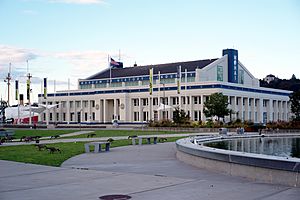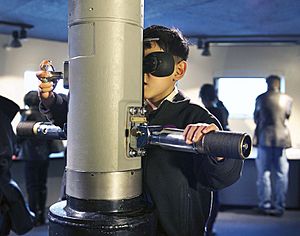- This page was last modified on 17 October 2025, at 10:18. Suggest an edit.
Museum of History & Industry facts for kids
 |
|

The MOHAI building (Naval Reserve Armory) at Lake Union Park, pictured in 2015
|
|
| Lua error in Module:Location_map at line 420: attempt to index field 'wikibase' (a nil value). | |
| Established | 1952 |
|---|---|
| Location | 860 Terry Ave N. Seattle, Washington, U.S. |
| Public transit access | South Lake Union Streetcar |
The Museum of History & Industry (MOHAI) is a cool history museum located in Seattle, Washington. It's in the South Lake Union area. MOHAI is the biggest private group in Washington state that focuses on history.
The museum has a huge collection of almost four million items. These include old objects, photos, and documents. Most of these items tell the story of Seattle and the nearby Puget Sound region. You can see about 2% of this amazing collection in the museum's galleries. MOHAI is housed in the historic Naval Reserve Armory building, right in Lake Union Park.
Some of the most famous things you can see at MOHAI include:
- The very first commercial plane made by Boeing, the 1919 Boeing B-1.
- The Petticoat Flag, a U.S. flag sewn by women during the 1856 Battle of Seattle.
- The giant 12-foot tall neon "R" sign from the Rainier Brewing Company.
Besides its permanent and changing exhibits, MOHAI also has programs for kids and adults. It often hosts public events with other groups in the South Lake Union neighborhood. MOHAI is approved by the American Alliance of Museums. It is also connected to the Smithsonian museums.
Discovering MOHAI's Past
The idea for MOHAI started way back in 1911. Morgan and Emily Carkeek hosted a special "Founder's Day" party. Guests dressed in old costumes and brought items from early Seattle. These parties led to the creation of the Seattle Historical Society in 1914.
Finding a Home for History
For a long time, the Seattle Historical Society didn't have its own building. They tried many times to find a permanent home. But money was tight, especially during the Great Depression. Also, the original members were getting older, and new people weren't joining.
Even so, the collection of historical items kept growing. In 1945, Boeing offered $50,000 to help build an aviation section. Over the next five years, the Society found a spot in Montlake. During this time, the Society became more open to the public. The Founder's Day event started including community groups. The new museum finally opened its doors in 1952.
Changes and New Beginnings
In the 1980s, MOHAI started making big changes. They created new exhibits and reached out to different communities. This was a new direction for the museum. By the 1990s, MOHAI had overcome its challenges. It began to expand its educational programs and community outreach.
The museum had to move from its Montlake location. This was because of plans to rebuild Washington State Route 520 and the Evergreen Point Floating Bridge. MOHAI and the City of Seattle decided to move the museum to the Naval Reserve Armory. This building would soon be part of Lake Union Park.
The Armory building needed a lot of work to become a museum. MOHAI raised $90 million to fix it up. They restored the original ceiling and floor. They also made big safety and accessibility upgrades. The museum closed its Montlake location in June 2012. Six months later, on December 29, 2012, MOHAI celebrated its grand opening in its new home in South Lake Union.
Exploring MOHAI's Galleries
MOHAI has several exciting galleries for visitors to explore. Each one tells a different part of Seattle's story.
True Northwest: The Seattle Journey
This is MOHAI's main exhibit. It's on most of the second floor. It takes you on a journey through Seattle's history, from early settlements to today. The exhibit has 22 different sections. Each section focuses on a special event or time in Seattle.
The museum's Creative Director, Ann Farrington, said it's "not a timeline, but a series of stories strung like pearls." This means it shows how Seattle's past, present, and future are all connected. You'll see many old objects and photos. There are also lots of interactive screens and games. You can touch screens or play games to learn about Seattle's history and culture.
This exhibit also has the Great Fire Theatre. Here, artifacts from the 1889 Great Seattle Fire "sing" the story of the event. There's also the Joshua Green Foundation Theater. It shows a 7-minute film about Seattle culture on two big screens.
Faye G. Allen Grand Atrium
The first floor of the museum is a huge open space called the Faye G. Allen Grand Atrium. You can see the original floor and ceiling of the Naval Reserve Building here.
Right in the middle of this space hangs the 1919 Boeing B-1. This was the very first commercial plane built by Bill Boeing. It's displayed as if it's flying onto Lake Union, just like it used to take off and land there.
On one side of the Grand Atrium, there's a three-story tall grid. It's filled with famous Seattle items. These include the neon Rainier "R" sign and a clam costume from Ivar's, a Seattle seafood restaurant. There's also a stuffed cougar donated by Eddie Bauer, who started the clothing store.
On the other side, you'll see a 64-foot-tall sculpture called Wawona. It was made by local artist John Grade. The wood for this sculpture came from the 1897 schooner Wawona. This old ship was taken apart in 2009 because there wasn't enough money to fix it.
Walker Special Exhibits Gallery
The Walker Gallery is where MOHAI shows its temporary and traveling exhibits. It takes up the entire southern side of the museum's second floor. When the museum first opened in Lake Union Park, this gallery had an exhibit about Seattle's connection to movies. It was called Celluloid Seattle: A City at the Movies. In 2015, the Walker Gallery hosted American Spirits: The Rise & Fall of Prohibition, which came from the National Constitution Center.
Linda and Ted Johnson Family Community Gallery
This is another gallery for temporary exhibits. It's on the third floor. This space is smaller than the Walker Gallery. It's designed to let the community be part of MOHAI. It shows projects made with community groups. The first exhibit here was a partnership with Arts Corps. High school students worked with photos from MOHAI's collection to create poetry.
McCurdy Family Maritime Gallery
On the top floor, there's a small gallery about Seattle's history with the sea. This space was originally built to look like a ship's bridge. It was used to train naval recruits during World War II. It has windows facing south that look out over Lake Union.
One of the most popular things in this gallery is a real, working World War II-era TANG periscope. It came from a naval submarine. You can look through it and get a 360-degree view of Lake Union and downtown Seattle! The Puget Sound Maritime Historical Society helps manage this gallery. They have worked closely with MOHAI since the 1950s.
Bezos Center for Innovation
MOHAI opened a big new addition on October 11, 2013. It's called the Bezos Center for Innovation. This project was made possible by a $10 million gift from Jeff Bezos, who founded Amazon. The center was designed by Olson Kundig Architects, a firm based in Seattle. It's located in a part of the museum's Grand Atrium.
More to Explore
- Arts in Seattle
- History of Seattle
- Bobo (gorilla)



